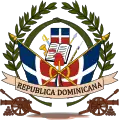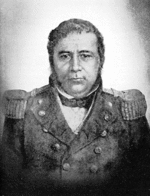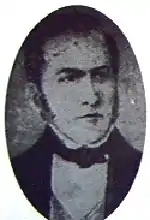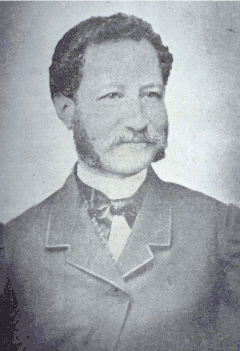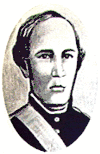Dominican Republic Spanish: República Dominicana | |||||||||||||
|---|---|---|---|---|---|---|---|---|---|---|---|---|---|
| 1844–1861 | |||||||||||||
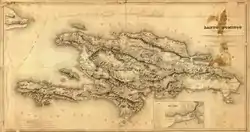 Map of Hispaniola from 1858. | |||||||||||||
| Status | Dominican territory | ||||||||||||
| Capital | Santo Domingo | ||||||||||||
| Common languages | Spanish | ||||||||||||
| Demonym(s) | Dominican | ||||||||||||
| Government | Unitary presidential republic | ||||||||||||
| President | |||||||||||||
• 1844–1848 (first) | Pedro Santana | ||||||||||||
| History | |||||||||||||
• proclamation of the Dominican Republic | 27 February 1844 | ||||||||||||
| 18 March 1861 | |||||||||||||
| Currency | Dominican peso | ||||||||||||
| ISO 3166 code | DO | ||||||||||||
| |||||||||||||
The First Dominican Republic,[1] was a predecessor of the currently existing Dominican Republic, and began on 27 February 1844 with the proclamation of the Dominican Republic, and culminated on 18 March 1861 with the annexation of the country to Spain. During these 17 years the nation was economically and politically unstable due to prior war against Haiti and internal conflicts. There were 8 governments (3 of which corresponded to Pedro Santana and 2 to Buenaventura Báez).
The era of the First Republic was a period of great importance in the country's history, as it marked the beginning of its independent life. This stage spanned from 1844 to 1861. The independence of the Dominican Republic was proclaimed on February 27, 1844, when a group of patriots led by Juan Pablo Duarte and other prominent Dominican leaders rebelled against Haitian rule. This proclamation marked the end of the Haitian occupation of Santo Domingo, leading to the establishment of the new nation. [2]
After independence, the new Dominican Republic faced a series of challenges, including the construction of a stable political system and the organization of the State structure. During this stage, the country's first Constitution was promulgated in November 1844, which established a republican and democratic system.
History
Background
In the previous decades, Santo Domingo had endured many changes in administrations. After being ceded to France through the Treaty of Basel, the capital was briefly controlled by Haitian forces in 1801, recaptured by France in 1802, and finally being reclaimed by Spain in 1809. It wasn't until 1821, when the colony finally declared its independence from Spain. The new nation was named The Republic of Spanish Haiti.
A year later, the governor of the new nation, José Núñez de Cáceres, having failed in his efforts to secure a deal with Gran Colombia, saw little other option than to cooperate with Jean-Pierre Boyer, who promised full support to the Dominican inhabitants in exchange for merging with Haiti. Upon Boyer's entrance to Dominican territory, he prolclaimed the abolition of slavery, and formally annexed the territory into the Republic of Haiti. This began the period of Haitian domination in Santo Domingo.
However, tensions arose within the eastern part of the island as the regime began implement forceful measures that deeply affected their interest; land expropriation were carried out, cultural practices and traditions (such as use of the Spanish language and the custom of cockfighting) had been prohibited, and heavy taxes were imposed. In addition, Boyer, unbeknownst to the Dominicans, agreed to accept an indemnity with France in exchange for the recognition of Haitian independence. In an effort to raise revenue to pay the debt, which amounted to 150 million francs (US$21 billion today), Boyer established the Code Rural, or forced labor, on the island. This fueled the perception of the Dominicans, who now viewed their Haitian overlords as "oppressors," unleashing strong resistance that accumulated into a series of attempts to liberate themselves from the regime.
The Alcarrizos Conspiracy of 1823
In the beginning years of the Haitian occupation, resistance to the regime began to take shape. In 1823, a group of conspirators, led by Baltazar de Moca, Antonio González, Juan Jiménez, and Pedro González, organized a movement to overthrow the government and rejoin Santo Domingo to Spain. Unfortunately, the plot was discovered by the governor, Jerome Maxinimian Borgella, who ruthlessly launched a military persecution against the rebels. Some were able to evade the authorities, while others, like Nova and Jiménez, were arrested and executed on Boyer's orders.
Boyer responded to the failed uprisings in a speech before the Haitian Congress, in which he noted:
"...the Republic continued to enjoy perfect tranquility, despite the fact that some fools, possessed by ambition and malevolence, had dared to manifest pernicious intentions in the East..."
La Trinitaria and Independence of 1844

On July 16, 1838, a young man, Juan Pablo Duarte, who grew tired of imperialism and foreign power imposed on his people, decided to form a secret society with other educated men who shared his ideals. They founded the nationalistic group, La Trinitaria, in honor of the Holy Trinity.
Presidents
| Santana
|
Jimenes
|
Santana
|
Báez
|
Santana
|
Regla Mota
|
Báez
|
Desiderio Valverde
|
|---|---|---|---|---|---|---|---|
| 1844 | 1848 | May 1849 | September 1849 | 1853 | 1855 | 1856 | 1857 |
| Santana
| |||||||
| 1858-1861 |
See also
References
- ↑ Negocios Dominicanos (2014). La Primera República. Negocios Dominicanos.com. Retrieved February 15, 2014.
{{cite book}}:|work=ignored (help) - ↑ Redacción (January 2, 2023). "Historia de la República Dominicana: Primera República (1844-1861)". HistoriaUniversal.org (in Spanish). Retrieved November 7, 2023.
.svg.png.webp)
